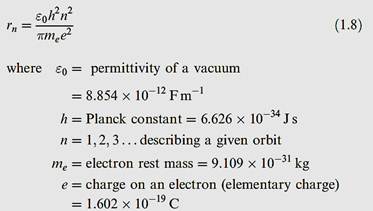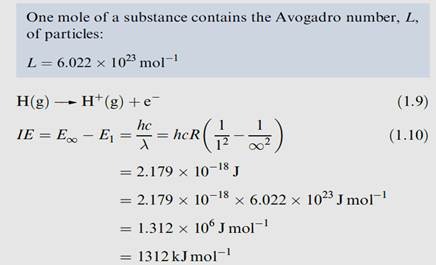

علم الكيمياء

تاريخ الكيمياء والعلماء المشاهير

التحاضير والتجارب الكيميائية

المخاطر والوقاية في الكيمياء

اخرى

مقالات متنوعة في علم الكيمياء

كيمياء عامة


الكيمياء التحليلية

مواضيع عامة في الكيمياء التحليلية

التحليل النوعي والكمي

التحليل الآلي (الطيفي)

طرق الفصل والتنقية


الكيمياء الحياتية

مواضيع عامة في الكيمياء الحياتية

الكاربوهيدرات

الاحماض الامينية والبروتينات

الانزيمات

الدهون

الاحماض النووية

الفيتامينات والمرافقات الانزيمية

الهرمونات


الكيمياء العضوية

مواضيع عامة في الكيمياء العضوية

الهايدروكاربونات

المركبات الوسطية وميكانيكيات التفاعلات العضوية

التشخيص العضوي

تجارب وتفاعلات في الكيمياء العضوية


الكيمياء الفيزيائية

مواضيع عامة في الكيمياء الفيزيائية

الكيمياء الحرارية

حركية التفاعلات الكيميائية

الكيمياء الكهربائية


الكيمياء اللاعضوية

مواضيع عامة في الكيمياء اللاعضوية

الجدول الدوري وخواص العناصر

نظريات التآصر الكيميائي

كيمياء العناصر الانتقالية ومركباتها المعقدة


مواضيع اخرى في الكيمياء

كيمياء النانو

الكيمياء السريرية

الكيمياء الطبية والدوائية

كيمياء الاغذية والنواتج الطبيعية

الكيمياء الجنائية


الكيمياء الصناعية

البترو كيمياويات

الكيمياء الخضراء

كيمياء البيئة

كيمياء البوليمرات

مواضيع عامة في الكيمياء الصناعية

الكيمياء الاشعاعية والنووية
Bohr’s theory of the atomic spectrum of hydrogen
المؤلف:
CATHERINE E. HOUSECROFT AND ALAN G. SHARPE
المصدر:
INORGANIC CHEMISTRY
الجزء والصفحة:
p5
19-12-2015
2710
Bohr’s theory of the atomic spectrum of hydrogen
In 1913, Niels Bohr combined elements of quantum theory and classical physics in a treatment of the hydrogen atom. He stated two postulates for an electron in an atom: . Stationary states exist in which the energy of the electron is constant; such states are characterized by circular orbits about the nucleus in which the electron has an angular momentum mvr given by equation 1.6. The integer, n, is the principal quantum number.


where m = mass of electron; v = velocity of electron; r = radius of the orbit; h= the Planck constant; h/2π may be written as ћ .
Energy is absorbed or emitted only when an electron moves from one stationary state to another and the energy change is given by equation 1.7 where n1 and n2 are the principal quantum numbers referring to the energy levels En1 and En2 respectively.


If we apply the Bohr model to the H atom, the radius of each allowed circular orbit can be determined from equation 1.8. The origin of this expression lies in the centrifugal force acting on the electron as it moves in its circular orbit; for the orbit to be maintained, the centrifugal force must equal the force of attraction between the negatively charged electron and the positively charged nucleus.


From equation 1.8, substitution of n = 1 gives a radius for the first orbit of the H atom of 5.293× 10 -11 m, or 52.93 pm. This value is called the Bohr radius of the H atom and is given the symbol a0. An increase in the principal quantum number from n= 1 to n=∞ has a special significance; it corresponds to the ionization of the atom (equation 1.9) and the ionization energy, IE, can be determined by combining equations 1.5 and 1.7, as shown in equation 1.10. Values of IEs are quoted per mole of atoms:


Although the SI unit of energy is the joule, ionization energies are often expressed in electron volts (eV) (1 eV = 96.4853 ≈ 96.5 kJ mol-1). Impressive as the success of the Bohr model was when applied to the H atom, extensive modifications were required to cope with species containing more than one electron; we shall not pursue this further here.
 الاكثر قراءة في مواضيع عامة في الكيمياء اللاعضوية
الاكثر قراءة في مواضيع عامة في الكيمياء اللاعضوية
 اخر الاخبار
اخر الاخبار
اخبار العتبة العباسية المقدسة

الآخبار الصحية















 قسم الشؤون الفكرية يصدر كتاباً يوثق تاريخ السدانة في العتبة العباسية المقدسة
قسم الشؤون الفكرية يصدر كتاباً يوثق تاريخ السدانة في العتبة العباسية المقدسة "المهمة".. إصدار قصصي يوثّق القصص الفائزة في مسابقة فتوى الدفاع المقدسة للقصة القصيرة
"المهمة".. إصدار قصصي يوثّق القصص الفائزة في مسابقة فتوى الدفاع المقدسة للقصة القصيرة (نوافذ).. إصدار أدبي يوثق القصص الفائزة في مسابقة الإمام العسكري (عليه السلام)
(نوافذ).. إصدار أدبي يوثق القصص الفائزة في مسابقة الإمام العسكري (عليه السلام)


















